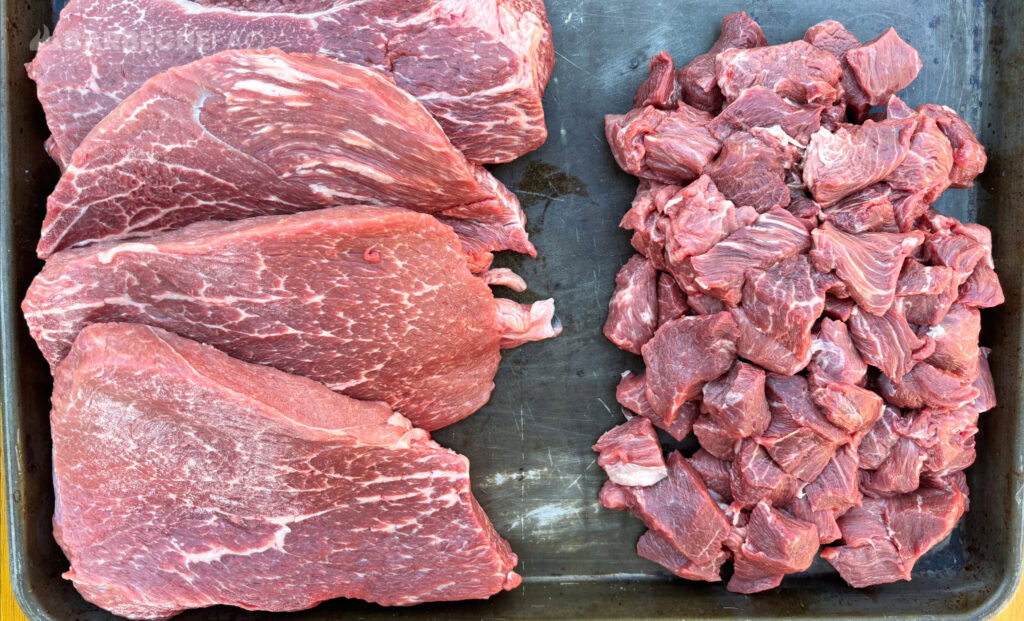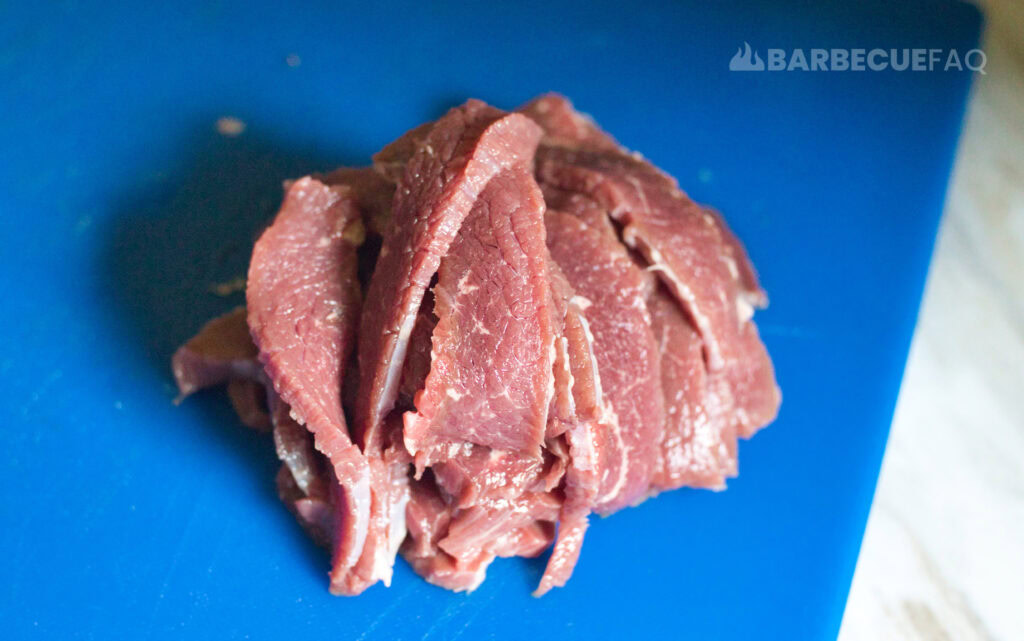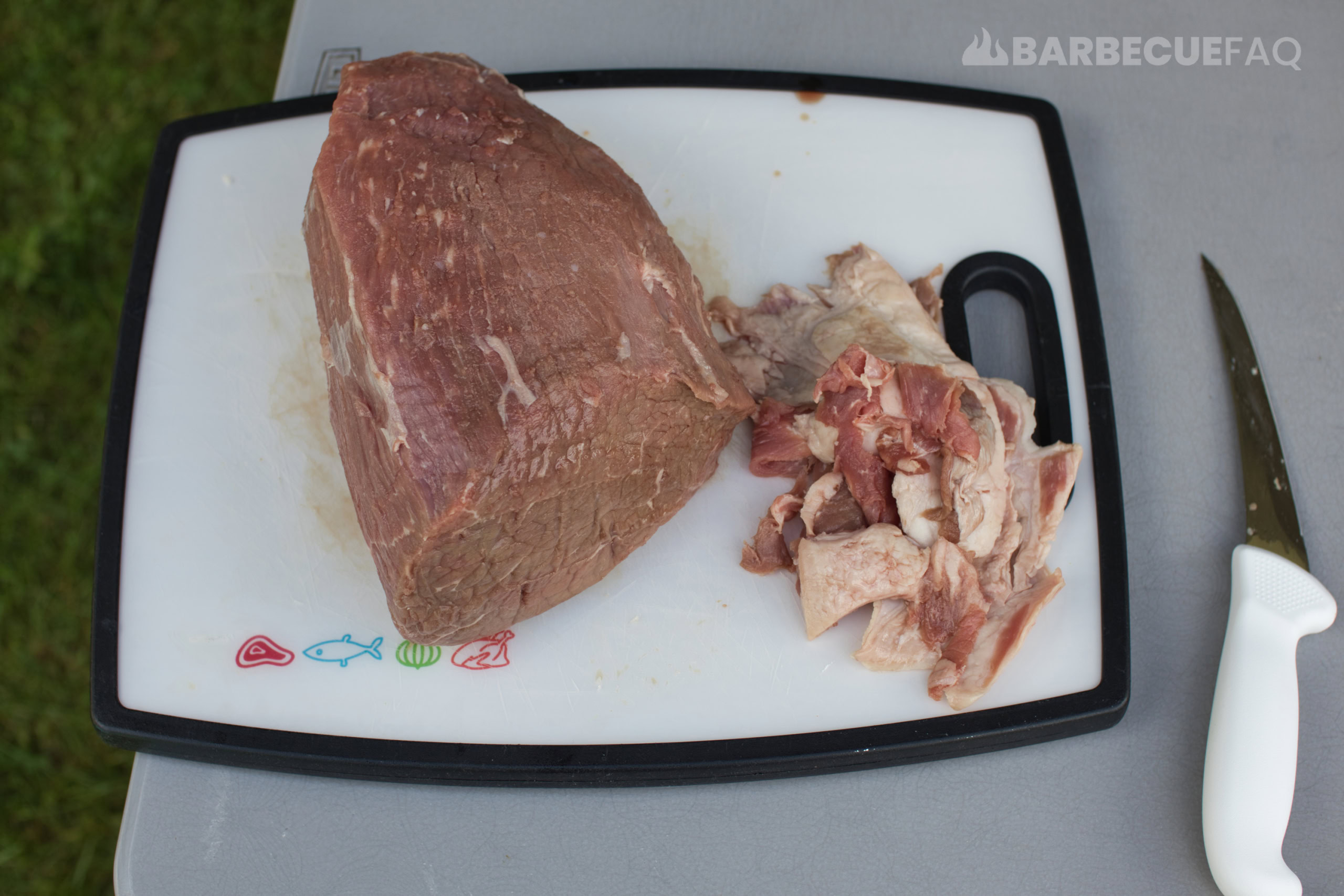Click a Cut of Meat to Learn More
What Part of the Cow Does Most Beef Jerky Come From?
Most Beef jerky usually comes from the hind legs of the cow called the round primal.

The main thing these cuts of meat have in common is they’re lean.
When making beef jerky, fat won’t render, rather it will go rancid.
Aside from being lean, cuts that are cheap on a per pound basis are also desirable.
London Broil

- Location on the Cow: Inside of the Rear Legs
- Characteristics: Lean, Beefy Flavor, Tender
- Average Cost: ~$4-6 per Pound
- Other Names: London Broil, Top Inside Round, Topside
People will use top round to make roasts, London broil (pictured above), Swiss steak, and it’s often cut thin to make roast beef.
Top round is typically more expensive than bottom round because it’s more flavorful and more tender.

When I got started making beef jerky, I often found that most of the brands I liked used top round and so I started using it for that reason alone.
Needless to say, check your favorite brands label!
It’s fairly cheap, easy to slice and tastes the best – in my opinion.
When buying Top Round as a roast – labeled “London Broil” – I’d suggest looking for meat that is void of veins or “gristle.”
Gristle isn’t palatable or edible; On the off-chance your top round roast has gristle – remove it.
Round Tip

- Location on the Cow: Front of the Rear Legs
- Characteristics: Relatively Lean, Beefy Flavor, Tender
- Average Cost: ~$4-5 per Pound
- Other Names: Knuckle, Sirloin Tip Roast, Ball of the Round
If you intend to make beef jerky with Round tip, look for the roasts or even whole muscles as apposed to steaks in order to save money.

I like to cut them up into small roasts for jerky meat and then some into beef stew meat.
I then vacuum seal and freeze everything for later.

Sirloin tip roast does tend to have more fat between muscle tissue as well as sinew (gristle).
This is more pronounced towards the end of the sirloin tip where the muscles start to articulate themselves.
This is why Butchers will cut it into stew meat and remove the gristle as they trim.
The beef is incredibly flavorful though and I find it to be tender – it’s also really cheap when on sale.
Flank Steak

- Location on the Cow: Found below the loin
- Characteristics: Lean, Beefy Flavor, Made Tender Cutting Against the Grain
- Average Cost: ~$9-12 per Pound
- Other Names: Bavette, London Broil
Flank steak is a heavily exercised muscle and as a result is rather fibrous and should be cut against the grain to make it softer for jerky.

Contrary to popular belief, the flank steak has minimal fat; There may be some exterior fat as a result of poor butchering but unlike the skirt steak, it’s quite lean.
Flank steak has become somewhat expensive though – this is especially true when compared to the round roasts.
However it has 2 of the main characteristics that make a good beef jerky – it’s beefy and lean.

If I was at a grocery store and they had London broil and flank steak, I’d go with the London broil every time simply due to price.
However, Flank steak is typically 2 lbs or less, is easy to cut, and requires almost no trimming.
All qualities that are great for first time jerky makers.
Brisket Flat

- Location on the Cow: Chest of the Cow
- Characteristics: Lean, Beefy Flavor, Made Tender by Cutting Against the Grain
- Average Cost: Location Dependent; Ranges from ~$4-10 per Pound
- Other Names: Lean Brisket, First Cut Brisket, Navel
When I make Beef jerky from Brisket I like to find really cheap select grade briskets and then separate the brisket into the point and flat muscles.
Of these two muscles the one that’s used for jerky is the flat (pictured below, to to the left) because it lacks intramuscular fat.

In terms of trimming, you may have to remove nodules of surface fat and silverskin. The silverskin will shrink and become chewy when made into jerky.

Depending on where you live, brisket flat is about the same price per pound as other round roasts and has a strong beefy flavor.
The only issue for me is availability.
I often can’t find brisket flat in New Hampshire and if i can, it’s usually only at Walmart for Cheap. At BJ’s wholesale club it’s often ~$8 per pound or more.
Bottom Round

- Location on the Cow: Outside of the Rear Legs
- Characteristics: Lean, Beefy Flavor, Less Tender than Top Round
- Average Cost: ~$4-5 per Pound
- Other Names: Silverside
Bottom round is a tighter grained muscle than the top round.
Due to this reason, this meat is usually used for ground beef, as cube steak, or for jerky or biltong.
A lot of other articles will put eye of round in front of bottom round in terms of their preference for jerky.
However, from the perspective of making jerky, this doesn’t make sense.
- What’s the fat content? – Eye of round wins because it’s more lean than bottom round and top round.
- What’s the price? – Bottom round is the cheapest option.
Bottom Round roast is cheaper and tastes better than Eye of round, by far.
Eye of Round

- Location on the Cow: Exterior of Rear Legs, Behind the Bottom Round
- Characteristics: Very Lean with an Exterior Fat Cap
- Average Cost: ~$4-5 per Pound
- My least favorite cut for beef jerky
Of the different round cuts, eye of round is typically what most resources would say is the best cut for beef jerky.
You can think of the eye round to be like the beef tenderloin – it’s similar in terms of size, shape, and fat content.

The major difference being the tenderness; Eye of round is substantially less tender than tenderloin.
People opt for the eye of round specifically because it’s the leanest of the three round roasts.
If your sole intention is preservation – it’s definitely the best option, by far.
In terms of taste though it’s pretty lackluster and I tend not to use it for my jerky.
It’s also pretty telling that almost no craft jerky operations use Eye of round. Where-as most use Top Round, Brisket Flat, or Round tip.
While Eye of round contains minimal fat, there is often an exterior fat cap; Butchers will tend to leave this fat cap on as the eye of round is used for roasts.
When making jerky, this fat cap is easily removed.

It’s worth noting that the natural cylindrical shape of the eye of round makes it easy for home-jerky makers to slice.
What Cuts Suck for Jerky?
Avoid cuts that are fatty or cuts that have lots of “marbling.”
While fat content is great for steak it is not useful for jerky because it won’t render.
To illustrate:
While flank steak and skirt steak are quite similar, where they differ is their fat content; Skirt steak has far more fat than flank steak.
Here’s a picture of both the inside and outside skirt steaks – the white striations in the lean meat are fat:

When making jerky, this fat won’t render and will go rancid.
Cuts that are heavily marbled are also typically rather expensive – which is why you also want to look for cheap cuts of meat.
For instance, tenderloin is probably the leanest cut on the entire cow and would make great jerky – but it’s also the most expensive on the cow; Meaning, it’s “bad” for jerky meat.





4 comments
Don
Incredibly useful, thanks
Dylan Clay
Happy to help Don!
Paul Ely
Jerky discussion is right on, thanks.
Dylan Clay
Thanks for the comment Paul.
-Dylan